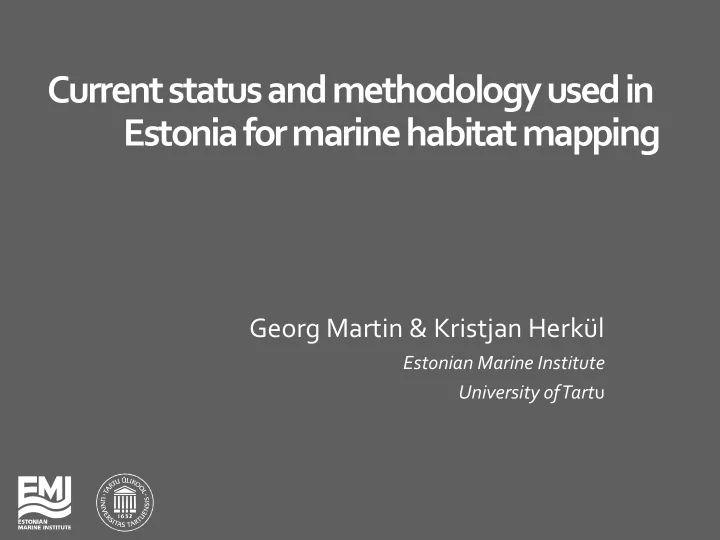

Current status and methodology used in Estonia for marine habitat mapping Georg Martin & Kristjan Herkül Estonian Marine Institute University of Tart u
Pu Purpose se of large ge scale le mappin ing/i g/inv nven entor tories es • Protection and management of nature values • Sustainable use of living and non-living marine resources • Basis for spatial planning of marine areas for minimisation of possible conflicts between different types of marine uses • International obligations (e.g. EU Marine Strategy Directive, HELCOM Baltic Sea Action Plan)
What are the most t importa rtant nt marine ne nature ure value ues? s? • Species (distribution pattern and dynamics) • Communities (e.g. Communities having ecological significant function) • Habitats • Single objects (interesting and unique geological formations) • Marine landscapes
Estonian sea area • Salinity: 3-7 PSU • Duration of ice- cover: up to 90 days/year Territorial sea: 25 200 km 2 • Largest depths: EEZ: 11 300 km 2 up to 140 m • Complicated bottom morphology • Diversity of coastal types Area: 36481 km 2
Current situation with benthic inventories in Estonian coastal sea First large-scale complex inventories started in 2005. (EU Life project “Marine Protected Areas of Eastern Baltic Sea) Project duration 2005-2009. Currently inventories are carried out in the framework of different projects having two main objectives: 1. Development of Natura 2000 network in Estonian coastal areas: ESTMAR (EEA Grants), Gretagrund, Krassgrund, Paljassaare inventories (Elf, KIK), Nõva-Osmussaare SCA (EU Life) 2. EIA studies for larger technical development projects (offshore windparks, construction and reconstruction of harbours and bridges, establishemnt of new fishfarm and sand and gravel mining areas etc.)
6 project areas Fieldworks 2006-2007 Habitat/fish/bird inventories
Classiffication system of benthic habitats developed in framework of EU Life project “Marine Protected Areas in the Eastern Baltic Sea” EBHAB Classification is based on physical and biological features: Exposure Substrate type (quality) Light avaialability (photic zone) Biological communities Alltogehther 25 classification units for Eastern Baltic Sea (18 for Estonian waters)
Habitat classification • EBHAB (Eastern Baltic marine benthic HABitats) SHELTERED MODERATELY EXPOSED 8. Fucus 9. Furcellaria HARD 1. Fucus 10. Mussels & barnacles 2. Mussels & barnacles 11. No dominance in photic zone 3. No dominance 12. No dominance in aphotic zone 13. Zostera marina 14. Vascular plants (excl. Zostera ) SOFT 4. Vascular plants (excl. Zostera ) 15. Charophytes 5. Charophytes 16. Furcellaria 6. Mussels & barnacles 17. Mussels & barnacles 7. No dominance 18. No dominance
• EU Habitats Directive Annex I marine habitat types – Sandbanks which are slightly covered by sea water all the time (1110) – Estuaries (1130) – Mudflats and sandflats not covered by seawater at low tide (1140) – Coastal lagoons (1150) – Large shallow inlets and bays (1160) – Reefs (1170)
Mapping based on field inventory • Establishment of the sampling grid • Field works • Drop camera • ROV • Grab samplers • SCUBA • Analysis of field data • visual data (dektop analysis): percentage cover of species/groups, sediment type • biomass data: biomass, abundance of benthic species • Interpolation: point data coverage data • Overlay analysis, cell-wise classification
Benthos sampling • Drop camera • ROV • SCUBA diving • Bottom grab samplers
Establishment of sampling grid Interpolation Benthos sampling Habitat maps Overlay analysis
>9600 km2
Predictive modelling approach Probability of occurrence of a key species Prediction: Response variable: Biological point data GIS-layer of biological response variable STATISTICAL Predictive variables: MODEL GIS- layers of e nvironmental data · Variable contributions · Variable response curves · Model validation
Predictive modelling method Input data Biological point data (response) • Coverage estimates from video and scuba • Biomass samples • Coverage, biomass presence/absence (binomial models perform better) GIS-layers of environmental data (predictors) • bathymetric: depth, seabed slope, aspect • wave exposure • salinity • temperature • sediment • currents
Predictive modelling method Statistical models • generalized additive models (GAM) • boosted regression trees (BRT) • random forests (RF) • Training data: 70-90% of biological point data • Validation data: 10-30% of biological point data • Validation method: ROC-test
Examples of modelling input data – species distribution
Available environmantal layers: • depth • Slope declination • exposure • sediment • salinity • temperature • currents • O 2
Results of modelling of species: bladder wrack, Furcellaria lumbricalis , Charophytes, vascular plants
Results of modelling of species: eelgrass, Mytilus, Balanus, infauna-Bivalvs
Areas where probability of occurence of characteristic species for habitat type „Reefs“ is higher than 0,5 and hard substrate Areas where probabilty of occurence of characetristic species for habitat type „sandbanks“ is higher than 0,5 and dominance of sandy susbtrate
Multibeam sonar (in use from 2013) • Reson SeaBat 7101-Flow • 511 equidistant beams • swath coverage 150° • frequency 240 kHz • depth range 0.5 – 200 m
Sonar measurements Processing of sonar data Depth Backscatter Slope Rugosity Unsupervised classification Habitat maps Ground truthing of classes
Sonar Processing of sonar data measurements Depth Backscatter Benthos sampling Slope Rugosity Modeling Species distribution maps
Future development Integrate different data sources and models to improve accuracy of bethic habitat maps Statistical methods Biological Remote point data sensing data Physical & Acoustic chemical data environment data Benthic habitat maps with high spatial resolution and accuracy
Data collection Modelling In situ sampling • Filling in gaps between ecological point data • Predicting biological and seabed substrate data Map production based on remotely sensed and other Distribution of: environmental data • key species • Methods: Remote sensing • habitats – interpolation • species – statistical models richness – machine learning Other environmental data • bathymetric data • hydrodydamic data: wave exposure, currents • salinity, currents, temperature etc.
• HELCOM Underwater Biotope and habitat classification (HELCOM HUB) – to be implemented in coming mapping projects
Area covered by mapping (2015): 12446 km 2
Recommend
More recommend